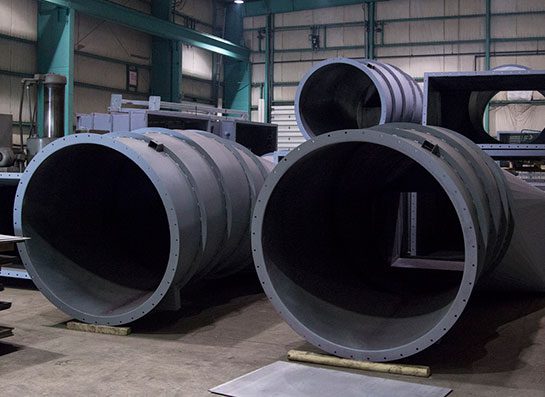Fabricating Large Ductwork

Industrial facilities rely on large heating and ventilation systems to maintain air quality, employee health, and quality assurance benchmarks. Ductwork plays a key role in these industrial systems. Large, secure passageways for airflow improve total system efficiency and reduce the likelihood of an air quality crisis. Discover how industrial HVAC systems use large duct networks to save money and support air quality goals.
What is Large Ductwork?
Standard residential and commercial duct systems rely on round ducts up to 18 inches in diameter or rectangular ducts up to 24 inches by 8 inches or slightly larger. The size of the duct directly corresponds to the average air volume measured in CFM (cubic feet per minute) needed to heat, cool, or ventilate a space. These residential-oriented ducts would overwork the machine and deliver subpar results if installed in a large industrial or manufacturing facility.
Large ductwork supports large-volume heating, cooling, and ventilation. Industrial/large ductwork features massive airflow passageways designed to keep pace with air volume requirements. The materials, gauges, and measurements of large ductwork set it apart from commonly used residential and commercial duct components. Engineers must calculate system airflow needs to maximize performance.
Some industrial systems also feature dust collection systems at key points within the duct network. These systems rely on a certain ductwork carrying velocity to bring industrial dust to the collection system. Large ductwork can better accommodate these industrial applications to deliver consistent air quality without overtaxing the system.
When to Consider Large Ductwork
Consider heavy-duty large ductwork systems in areas that rely on consistent temperature management and efficient dust collection/ventilation. Industrial facilities that grind metal, process wood, handle chemicals, or handle food processing can all benefit from a custom large ductwork system. Any process that creates health hazards in an enclosed environment will benefit from a properly sized duct system.
Duct systems that are too large or too small can impede airflow levels, ventilation, and dust collection system performance. A generic system may save money upfront, but fail faster than properly sized and quality-fabricated systems.
Components of Large Ductwork Systems
Industrial applications generally call for one of two types of large ductwork systems – tapered or plenum. Tapered ducts gradually increase in diameter while maintaining a constant airflow speed. They often funnel air to a dust collection system to quickly remove particulates from the environment. Plenum duct systems offer traditional HVAC airflow that networks into the facility from an industrial-sized air-distribution area.
Large ductwork systems often feature galvanized, stainless, or rolled steel constructions to deliver maximum performance in an industrial environment. Duct pieces can connect via flanged or clamped edgework for a secure fit, and custom components fitted to maximize airflow around bends and into ventilation shafts. Industrial environments need carefully designed, fabricated, and installed components to meet regulatory air quality standards and minimize system maintenance requirements.
Investing in Large Ductwork
Large ductwork needs the right design, material, gauge, adaptors, and fittings to perform well in industrial and large manufacturing environments. Prefabricated industrial ductwork systems may not offer the same performance level or value in these settings as a custom fabricated design.
Swanton Welding offers complete custom ductwork fabrication services to give industrial facilities a better air quality experience. Come to us for traditional HVAC ductwork and dust collection/ventilation systems in any industrial environment. Call us at (419) 826-4816 to learn more about our large ductwork fabrication capabilities.

